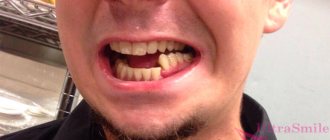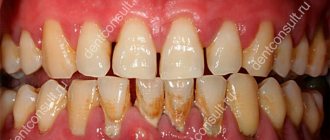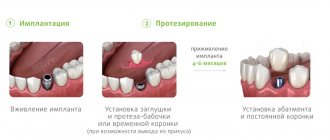Quite a strange question from a clinic that provides dental implantation services. But our task is not to install as many implants as possible, but to solve the problem with which you come to us, prepare you and honestly tell you about all the nuances, including the unpleasant ones.
So, there is an empty space in the dentition. Are you sure that implantation is what you need? And no wonder: in transport, newspapers, and on the Internet there are full of advertisements about the advanced method - dental implantation. Painless, long lasting, “set it and forget it”
,
“the tooth is like a native one”
and so on. Is it so?
Yes, yes. Nothing better has yet been invented in world dentistry. As a result, you will get a fixed tooth that will serve you without creating a load on the neighboring ones, which you will stop thinking about, just as you don’t constantly think about the rest of your teeth. But advertising remains advertising. They show you the end result - a beautiful smile, happy eyes, a healthy appearance. What will you have to go through to get the picture you want?
Let's ask patients who have already installed implants:
Nikolay, the operation took place in 2010: “What will you have to go through? Frankly speaking, a couple of circles of hell. Once you decide to get an implant, forget about long trips for a year - you will be tied to the clinic and the doctor who monitors the implant healing process. But I’ll be honest – the result is worth it...”
Preparation
First - stop smoking! Even if the implant takes root, it will not last long - for a smoker, if he does not want to give up his habit, it is better to forget about implantation - do not torture yourself in vain!
Second, you need to have time and patience. The implant takes root in different ways: for some it takes 2-3 months, for others it takes six months or more.
Zhanna, the operation took place in 2011:
“If you are a woman and are planning a child, choose one thing: dental implantation or pregnancy.
It is very difficult to combine both without harming yourself or your unborn child. The doctor forbade me to breastfeed after the operation...” Get ready to donate blood and have a CT scan of your jaw. Ideally, you should come to a consultation with an implantologist with a disk on which your 3D image is recorded - this will speed up the decision-making process and bring the surgery time closer.
Indications and contraindications for implantation
You can resort to implantation in case of partial or complete loss of teeth. This operation helps restore the dentition after the loss of one or more teeth, and also solves the problem of edentia.
However, the use of implantation methods is not always possible - the procedure has a number of contraindications:
Absolute
- Severe diseases of the cardiovascular, nervous, endocrine, respiratory systems (diabetes mellitus, osteoporosis, tuberculosis, oncology, poor blood clotting, mental disorders, etc.).
- Recent chemotherapy or organ transplantation – during this period there is a disruption in the body’s restorative functions, which can lead to rapid implant rejection.
- Allergy to any type of anesthetic - the operation itself is very painful and cannot be performed without pain relief.
- Pregnancy and breastfeeding.
Relative
- Any diseases of the oral cavity (they must be eliminated before installing implants);
- Insufficient hygiene (before installing implants, it is necessary to remove tartar and plaque);
- Malocclusion (corrected with braces);
- Bone atrophy (corrected through bone grafting);
- Vitamin deficiency, exhaustion of the body, stress (implantation is acceptable after complete recovery);
- Smoking more than 1 pack of cigarettes per day - after surgery this leads to implant rejection (before implantation it is necessary to get rid of the bad habit or reduce the number of “consumed” cigarettes as much as possible);
The dentist will also recommend avoiding extreme and traumatic sports to reduce the risk of mechanical damage to the implant.
As for age restrictions, there are none (with the exception, of course, of childhood and adolescence) - the possibility of implantation is determined not by the biological age of the patient, but by his general condition (often older people tolerate the procedure much easier than younger patients).
In any case, the possibility of performing an implantation operation is determined by the doctor.
Surgery and postoperative period
The process itself will be painless and short-lived - you will be given good local anesthesia and the implant will be quickly installed. But even here there is a pitfall: you may need an operation called a sinus lift.
— implantation of artificial bone if yours has atrophied. The procedure is short but expensive. It is usually carried out during implantation in the area of the upper front teeth.
Gennady, the operation took place in 2011:
“Immediately after the operation they will not let you go home - they will give you ice and force you to hold it against your cheek for 20-30 minutes.
Be prepared to take antibiotics. To prevent infection, the doctor will prescribe you a whole course. Talk to your gastroenterologist about restorative therapy in advance. In any case, I simply needed a gastroenterologist for my pancreas.” Elena, the operation took place in 2012:
“Don’t wait until the anesthesia starts to wear off—take a painkiller.
Otherwise, you will have to experience severe pain that will not go away within 2-3 days. During this time, take any pain medication your doctor prescribes or that usually works for you. Don’t torture yourself - your pain is not needed by anyone, and, above all, by yourself. I had to take a long sick leave to come to my senses...” Temperature, weakness, swelling, numbness, inflammation are your possible companions. The best thing you can do for your body after surgery is to establish bed rest, at least for 1-2 days, and preferably for 3-5. Do not go to crowded places, do not play sports or lift heavy objects, do not sunbathe.
In the first week, establish a diet - exclude salty, spicy, sour, and hard foods. Forget about alcohol!
The next day, a week, a month later - control x-rays to monitor the process of implant healing and the absence of complications. Here you can expect: suture dehiscence, reimplantitis (inflammation of the bone tissue around the implant), implant rejection. Then the process will last for several more weeks - in the worst case, the implant will have to be reinstalled. Be prepared for this situation as well.
Anna, both operations took place in 2013:
“Honestly, there were several moments when I wanted to give up everything.
It seemed to me that doctors were playing it safe, and without any reason. I was afraid to go to the appointment and take a picture, because I didn’t want to hear the phrase “Come back in 2 weeks, it’s too early.” I had the implant installed again, and I was ready to give up my idea. But I was well supported by my husband, parents, nurses and the doctor himself - and when, finally, everything was left behind, I was happy. Previously, it seemed to me that I would never dare to do this again, but now, after 2 years, I am beginning to understand that nothing could be better than an implant...” Follow all the doctor’s recommendations, then the risk will be minimal. Do not hesitate to arrive before your appointment, or call the clinic if your condition worries you.
Approximate costs at this stage:
- Operation to install an implant (possibly repeated) – from 25 thousand rubles
- Sinus lifting (possibly) – from 20 thousand rubles
- Control x-rays – from 1000 rubles, depending on the required quantity.
- Necessary medications – from 2 thousand rubles
How to choose the right implant?
Today, dental clinics offer dozens of brands and models of dental implants. For most patients, the main factor when choosing implants is cost. It’s quite difficult to blame them for this. As already mentioned, the price difference between different models can be very large. For example, elite implants from Straumann or Nobel Biocare are on average more than twice the cost of implants produced in South Korea and Israel.
On the other hand, the survival rate of economical implants is also very high, since they are made from modern titanium alloys (for example, grade 4), and, as a rule, have a modern SLA coating, which helps ensure high-quality osseointegration. Economy class implants may well be recommended in standard clinical situations. This means that the doctor did not find any nuances that complicate obtaining a high-quality functional and aesthetic result.
It cannot be said that inexpensive implants “give in” to the slightest difficulties, however, in unusual situations, doctors most often recommend luxury implants. Thanks to advanced technological solutions that are designed specifically for implantation if the patient has certain limitations, the problem is solved better, and the doctor achieves a more predictable result.
Situations when it is better to use premium implants:
- implantation for bone deficiency;
- implantation in the presence of narrow interdental spaces;
- implantation of anterior teeth when achieving ideal aesthetics is required;
- The patient is allergic to titanium.
Installation of the healing abutment
When the doctor is sure that the implant has taken root, he will install a gum former for you. The name speaks for itself: the former is needed to prepare the gums for future prosthetics: installation of an abutment and crown.
Oleg, the operation took place in 2013:
“You know, after the operation and recovery, installing the shaper is just kindergarten, easy. It felt like a filling had been placed, at least in terms of time it was approximately like that. I spent 2 weeks with the former, and then they took impressions and put a crown on me within a month. Beauty!"
Approximate costs at this stage:
- Installation of a gum former: 5 thousand rubles
- X-rays (possibly) from 300 to 1200 rubles
Company goals
The abbreviation BTK combines Biocompatibility, Technology and Know-how. And in its mission, Biotec declares its desire to offer patients affordable and highly personalized solutions in the field of implantation, thereby improving their quality of life. The company's management strives to ensure that its products become the standard in the dental implants market. Biotec Academy regularly conducts training seminars around the world, including in Russia. However, so far the BTK brand clearly does not reach the industry leaders in popularity - Nobel Biocare, Straumann, Astra Tech.
Prosthetics on an implant
If everything else went well before this stage, then installing the abutment and the crown on top takes from a week to a month. Prosthetics on an implant is similar to conventional prosthetics, only the support is not your own tooth root, but a titanium one.
Irina, the operation took place in 2014
“Prosthetics began at the peak of my nerves. I am a suspicious person, and it seemed to me that they were deliberately dragging out deadlines for me (of course, nothing like that happened, but I later realized this), they were not telling me something. I was hysterical, cursing - it’s a shame to remember. Now, taking this opportunity, I would like to thank the doctors and other staff for their patience and care. And give advice to patients: be patient, and everything will work out! The prosthetics ended unexpectedly quickly (and I was determined to walk for a long time). One fine day I smiled in the mirror and burst into tears of happiness right in the doctor’s chair...”
Approximate costs at this stage:
- Temporary abutment (possibly) – 1850 rubles
- Temporary crown (possibly) – 1050 rubles
- Abutment: from 5 thousand rubles
- Crown: 18 thousand rubles
- Casts, models, fixation: from 2 to 3 thousand rubles
produces four main series of dental implants
LIKO-M
Universal model of Russian implants IRIS. It has excellent strength and reliability indicators, accelerated osseointegration, and is equipped with a system that prevents the risks of loosening and twisting of implants.
LIKO-M EVOLUTION
The implants of the series are used to perform surgery when the volume and height of bone tissue is insufficient. They can be used in express implantation because they provide high-quality primary stability and avoid injury to the jaw bone during installation.
LIKO-M SLIM
Implants from this line are used when there is insufficient bone height or low bone density. They have a minimal diameter - up to 3 millimeters, but at the same time provide high primary stability; they are most often used for the restoration of lateral incisors.
LIKO-M MINI
Systems from this line are used in mini-implantations, allow for firm fixation of removable orthopedic structures, and are suitable for patients with complete edentia.
The price of Russian IRIS implants is quite affordable for a wide range of patients - it amounts to 6,000 rubles per unit.
Calculate the cost of treatment by taking a short test in 20 seconds!
Do not delay your treatment, because in this matter time plays against us.
Implant aftercare
You are happy about your new teeth, but do you remember the first conversation with the doctor, even before the whole procedure began? He told you about mandatory oral hygiene, using special means:
- Toothbrush: at least 2 times a day and after every meal. Brush your teeth using massaging movements, alternating circular and sweeping movements.
- Dental floss (floss, superfloss). The spaces between teeth must be cleaned, otherwise plaque that is harmful to implants will accumulate there.
- Irrigator. Be sure to purchase it, because the irrigator is the savior and friend of your implants. A needle-thin stream of water will clean plaque from the area where the crown adheres to the gum, get rid of the unpleasant odor and prevent the destruction of the crown.
- Professional hygiene. Now you are a regular client of the dental hygienist. Once every six months you definitely (required!!!) need to do professional hygienic cleaning: ultrasonic plaque removal and AirFlow treatment
Alena and Konstantin, operations took place in 2015:
“We placed implants together, supported each other. Everything went well, and we understood that now we are more responsible for our teeth than before. After all, once we didn’t save them - we lost them, so now, having spent so much money and effort on implantation, I would like to observe the result for as long as possible. In general, a lot depends on the person himself: whether he smokes, whether he drinks often, whether he cares about his health... Previously, brushing your teeth took 2-3 minutes, now it takes 10-15, because you need to go through everything with an irrigator and floss..."
Does it hurt to get dental implants?
Contrary to popular belief, dental implants do not hurt. The fact is that this procedure is carried out using modern local anesthetics, and for the most sensitive patients the use of sedatives and even general anesthesia is provided:
- Local anesthesia
. The easiest way to eliminate painful sensations. During the implantation process, the drugs ultracaine, articaine or mepivacaine are used - they perfectly block nerve endings, and the analgesic effect can last for 2 hours after the procedure. Anesthetic injections are made directly into the operated area (infiltration and conduction anesthesia) or into the base of the skull to block the trigeminal nerve (trunk anesthesia). If the drug is selected correctly and the required dose, the patient does not experience pain, but feels all the manipulations performed by the doctor. It is for this reason that local anesthesia when installing implants is supplemented by the use of sedatives for patients who are particularly sensitive and fearful of dental intervention. - Minimal (superficial) sedation (anxiolysis)
. It is used in patients who experience anxiety during complex dental procedures - as a result, anxiety and fear go away, the patient is conscious (a feeling of slight drowsiness is possible), and follows all the doctor’s commands. - Moderate sedation
. If the patient is afraid of any medical intervention, it is possible to use moderate sedation - in this case, a little more sedative is used, as a result of which the patient remains conscious, can respond to the doctor’s commands, but is half asleep. - Oversedation
. It is also called deep sedation - increasing the dose of sedative puts the patient to sleep, while there is a reaction (sometimes with a slight delay) to a loud call or other external stimuli. In this state, the patient does not feel anything (provided that a local anesthetic is used), and he has virtually no memories of the installation of dental implants. Awakening occurs within 15 minutes after stopping the supply of the sedative drug (can be performed either intravenously or inhalation, using a mask). - General anesthesia
. This anesthesia technique is used in patients with allergies to any types of local anesthetics, with an increased gag reflex, in people who experience panic fear of dental treatment (dental phobia), in children. In addition, the dentist will recommend general anesthesia if during the operation it is planned to install more than 6-10 dental implants in combination with bone grafting. Consciousness is completely switched off, there is no reaction to any external stimuli, pain is not felt, any muscle activity is excluded, respiratory function is maintained using a ventilator. The use of general anesthesia requires the presence of an experienced anesthesiologist during dental implantation. Awakening occurs 20 minutes after the administration of the anesthetic, but it is advisable to remain under medical supervision for at least 40 minutes.
Sedative effect - reduction of irritability, relief from feelings of excitement or fear due to the use of special drugs - psycholeptics. Sedatives are not anesthetics, so during the installation of dental implants they are used exclusively in combination with local anesthetics.
The patient's condition under deep sedation and general anesthesia is similar. The only difference is that oversedation does not imply an anesthetic effect - pain sensations persist, and the patient remembers them, which can cause panic fear of dental treatment in the future.
In the process of choosing a specific type of anesthesia, the doctor is guided by the following factors:
- Patient's pain threshold (people with a low pain threshold most often require deep sedation or general anesthesia).
- Experienced fear or anxiety during dental operations.
- The presence of allergic reactions to certain types of anesthetics and sedatives.
- Vomiting reflex. In many patients, it manifests itself while dental instruments are in the oral cavity. A strong gag reflex can become a serious obstacle to the quality work of a doctor.
- The complexity of the upcoming operation.
The answer to the question of whether it is painful to place a dental implant directly depends on the correctly selected type of anesthesia - if suitable drugs were used during the operation, the patient will not experience any discomfort.
Before the procedure, the doctor conducts a thorough examination of the oral cavity, studies the patient’s medical history and X-rays, based on which he draws up a preliminary operation plan (single-stage, one-stage, two-stage) and selects the appropriate method of pain relief.
Reviews about dental implantation
Innocent
“At the beginning, I doubted for a long time whether I should undergo implantation. But still, one fine day I went and did it. You know, I didn't regret it. Yes, it was unpleasant in places and there were these restrictions, but the result outweighs all the disadvantages.”
Lena
“A couple of days ago my teeth were restored and 2 implants were inserted. I couldn't be happier with them! I finally have a full smile! One thing that was upsetting at first was the pain during and after the operation, and also the fact that I had a swollen cheek for two days.”
Svetlana
“I’ll tell you straight, it was scary. Before the operation itself, I was tormented by questions: will it hurt me, how much will it hurt, will there be any problems when they install new teeth for me, is this dental implant reliable, will it not fall out, what if I look worse with it, etc. In the end, I didn’t remember the procedure itself - they gave me an injection, fell asleep, and woke up with new teeth, like in a fairy tale. I was happy. The doctor said something and prescribed it, but I had no time for it. Then I realized that I should have listened, but it worked out too - I got sick for a couple of days and stopped. Yes, and for the sake of such beauty one can endure”
What about expensive and time-consuming?
Yes, implants are not cheap. But dentures and bridges need to be replaced regularly, but implants will last you for the rest of your life. And with “long” everything is no longer so simple. There are different implantation protocols. Two-stage procedures, also called classic, take several months. But now implants with immediate loading are becoming more common. In just one day, you can insert implants and crowns. No holes in the teeth or long waits. Temporary crowns carry the entire functional load without causing any hassle.
It’s not that expensive anymore and it won’t last long, but still, where is the best place to get dental implants?
There are several criteria that will help with your choice.
Price
If the advertising brochure indicates a “turnkey” cost and it is very attractive, then it is better to clarify what exactly is included in this concept. Different centers interpret this concept differently. Is it simply the installation of an implant or is it a pin, the work of a doctor, an abutment (transitional element) and a crown? In a good clinic, the turnkey price includes all diagnostic and therapeutic procedures, no additional expenses. The patient immediately sees whether the service fits into his budget.
What affects the price
- Cost of the implant itself
The price range is quite significant. Traditionally, Swiss implants are considered premium products. Korean and Israeli - budget ones. German and American occupy an intermediate position. Chinese implants are a “pig in a poke”; you can never guess with quality.
- Installation protocol
The one-step protocol is more expensive. At first sight. After all, when installing implants with immediate loading, the number of visits is significantly reduced. This method requires less manipulation and the rehabilitation period is shorter. For a nonresident patient, this method can, on the contrary, save money. And there’s nothing to say about time.
One-stage protocol with immediate loading
However, it's always good to have a choice
. If the patient prefers a two-stage protocol, the price will be lower.
Two-stage classical implantation with delayed loading
- Clinic equipment
An ancient X-ray machine, inherited from Soviet dentistry, significantly saves money. It just gives out little information. Modern equipment is expensive, but the examination is detailed and takes into account all the features of anatomy.
- Qualification of doctors
Between a beginner and an experienced implantologist, the choice is obvious. But you have to pay for qualifications. The doctor invests in his training and improving his skills.
The patient invests in the quality of the procedure, in the ability to place an implant and forget about it.
- Additional manipulations
Sometimes, before installing an implant, it is necessary to sanitize the oral cavity, treat adjacent teeth, or stop the inflammatory process. This also affects the cost.
So which is better? Implantation or prosthetics?
It is wrong to answer this question remotely. It may happen that you have absolute contraindications for implantation, which you do not know about and which can be identified during diagnostics, which are always carried out in a clinic. Therefore, in order to make a choice between prosthetics and implantation, you must consult two specialists at once - an orthopedist and an implantologist.
If you are thinking about restoring your teeth with implantation or prosthetics and don’t know which technology will be better in your case, make an appointment with the specialists of our clinic in Moscow - “Aesthetica”! One of the main principles of our work is honesty with patients. We recommend only those dental restoration technologies that are fully capable of solving the patient’s problem and at the same time are absolutely safe for his health!
What guarantees does the patient receive?
No matter what dentistry website you visit, there will be a lot of promises there. You can get confused. Or see the words “lifetime warranty” and decide – this is what you need. There is no need to rush, because there are different guarantees.
Implant warranty
It is she who will most likely end up with a lifelong sentence. All well-known manufacturers provide a lifetime warranty on their implants. Knowing that the pin will not rust, fall apart or oxidize is certainly nice. What happens if the implant does not take root? There are clinics that undertake reinstallation of the implant in case of rejection. Implantation is a complex, multi-stage process and I would like to be sure of the quality at all stages
Doctors' work guarantee
Here everything is not so rosy. Only dental centers that are confident in the professionalism of their implantologists and value their reputation take on such obligations. Only highly qualified doctors can deliver high-quality implants. Typically, warranties for doctors' work are not as long as for products. On average, this is 1, maximum 2 years. It is important to understand that the clinic bears responsibility under the contract in case of trouble. A large center will be in its place in 2 or 3 years, but a tiny dentistry can close at any time. Along with it, warranty obligations will disappear.
Licenses and certificates
A clinic where an implant can be installed must have a license for this type of activity. Certificates confirming partnerships with supplier companies protect against counterfeiting. Doctors are awarded certificates upon completion of training on working with a specific brand. Typically, dental centers are proud of their achievements and display documents for public viewing. If certificates and licenses are not visible, something is wrong with the clinic.
What is a surgical guide for implantation? Why is he married? Is it included in the cost of the operation?
A surgical template is a special device for the correct installation of implants, which is usually made by an orthopedic dentist at the stage of planning the operation. In fact, the task of any surgeon performing an implantation operation comes down to the correct protocol installation of the “screw”. But an implant is not an end in itself, it is only an intermediate stage of prosthetics. Those. The implant placed by the surgeon still needs to be somehow fitted with a crown or some other structure. And here it is very important that the implant not only “grows” to the bone, but also stands correctly. What does right mean? In the right place, with the right slope, at the right depth... i.e. it should not just be placed “by eye” of the implantologist, but oriented in a certain way. Because later it may turn out that the implantologist has his own “eye”, and the prosthetist has his own. So, just so that both doctors, working together for a single result, understand each other, a template is necessary. It most often looks like a removable denture.
This is what one of the surgical template options looks like. During the operation, the implantologist will position it in exactly the same way and will no longer be able to place the implant crookedly and in the wrong place where the orthopedist needs it.
To make it, the prosthetist must take impressions in advance and clearly plan the position of future crowns, so that later it does not turn out that the implants are in the wrong place. This is especially important when carrying out large operations, when a large number of implants are placed, and the surgeon does not have any landmarks in the form of neighboring teeth. It is also very important to have a template in anterior surgeries when it comes to achieving maximum aesthetics. If there is a template, the surgeon will apply it to the surgical area during the operation, and then there will be no need to guess how exactly to orient the implant in 3-dimensional space.
A surgical template, as a rule, is not included in the cost of the operation, since, despite everything written above, it is not needed in 100% of cases.
And now I want to show a clear example of what results can be obtained without planning the installation of implants.
This photo shows the sad result of illiterate installation of implants. A young girl lost her front teeth due to injury and the surgeon decided to give her implants without planning treatment with an orthopedist. Just a couple of weeks after the prosthetics, the patient realized that with such teeth she could not smile normally. The result of the treatment was absolutely disastrous from an aesthetics point of view, although both implants took root well.
The reasons for this result are clearly visible here. The implants were placed according to the scheme “like the surgeon’s right hand itching.” They are installed at different angles, at different depths, without taking into account the need to form the correct gingival contour. In this case, an implant system was used, which has limitations in the possibilities of prosthetics, so it is impossible to correct the situation with crowns. Unfortunately, in this case, the only option to fix everything is removal of the implants, bone grafting and re-implantation.
After removal of the implants, the patient was given a banal temporary removable denture (the so-called “bird”), the aesthetics of which are much better than the previously installed crowns on implants.
Diagnostics
During implantation, even the smallest details are important, so the availability of modern diagnostic equipment is an indispensable condition when choosing a clinic. It is unlikely that anyone would want to go somewhere to get a tomography or panoramic photo. Own equipment not only saves patients time, it allows doctors to use it constantly, get used to it and know what to expect. A well-equipped clinic must have an X-ray machine, both regular and for panoramic images. Tomography helps assess the volume of bone tissue, a panoramic image gives a complete picture of the structure of the jaw, and a targeted image determines how best to install the implant. One of the criteria for choosing where to do dental implantation should be the availability of modern diagnostic equipment.
Computed tomography and 3D planning of future surgery
Advantages of restoring lost teeth with implantation
The benefits of dental implant restoration include:
1. Long useful life of implants. Many implant system manufacturers offer a lifetime warranty on their product.
2. Installation of implants allows you to obtain an aesthetic result of restoration - artificial teeth on implants cannot be visually distinguished from natural ones. In addition, after implantation, the correct chewing load is completely restored, side effects such as impaired diction, discomfort when chewing food do not occur, and the jaw bone tissue does not atrophy.
3. During implantation, there is no need to grind and depulp healthy teeth. In addition, during implantation, the chewing load will fall on the artificial root, and not on the adjacent teeth, which is important for maintaining their health.
4. Implantation is universal; it will allow you to restore any number of teeth.
5. Even if the prosthesis installed on the implant is damaged, the implant itself will not have to be removed to replace it. They will simply make you a new orthopedic structure, which will be placed on an artificial root.
But implantation also has certain disadvantages that are important to consider. The disadvantages of dental implantation include:
1. Quite a wide range of contraindications.
2. High price. Implantation is more expensive than prosthetics.
3. Implantation is a surgical intervention and therefore is more traumatic compared to prosthetics.
4. Long overall treatment periods. For example, with classic two-stage implantation, the total treatment period can be 8-12 months.
5. The need for bone grafting. This need does not always arise, only with severe bone atrophy in the area of implantation. It is impossible to install an implant into a thinned and lost bone so that it holds firmly, which is why an operation is performed to build up the bone tissue to the required parameters. This operation increases the treatment time and the cost of implantation.
However, despite some disadvantages, it is implantation that allows you to get the most durable and aesthetic result of dental restoration without causing harm to healthy teeth.











